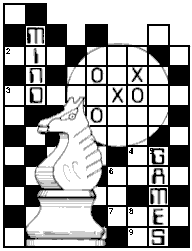| mind games |

Quentin Heath emerges from the dungeons to return to the boards
IN THE LAST few months I have been stuck underground in the Sinclair User dungeons with a variety of man-eating monsters, so this month I thought I would seek some fresh air and talk about chess.
In later articles I want to say something about the structure of chess programs but for now I will introduce you to what is available for Sinclair machines.
Most of the early ZX-81 games were, more or less, copies of a famous American chess program called Sargon. Many manufacturers used the Sargon basic structure and re-wrote the printing routines so that they would be compatible for the ZX-81 screen format.
After a few months of copying, manufacturers began to alter programs to make them play better and run faster. Out of the first batch of games to arrive on the scene, the Artic Computing ZX-81 Chess was acclaimed the best by the critics.
The original Artic chess, and its upgraded version, Chess Two, have sold well and with good reason. The games include all legal moves, with castling and en passant, and can be played at six levels. The easiest level has a response time of about one second and the most difficult, level six, takes several minutes to make a move.
Chess Two plays a good entertaining game for anyone with a slight knowledge of the laws of chess and when I played with it the game did not make an incorrect move, even on the simplest level. It is the game I would recommend for the average player who wants to try to beat a computer at chess. Some people may argue that a computer can play only a mechanical game with no invention or luck but playing a computer will give you some practice if no partner is available.
Artic also produces a technically-excellent game which fits into the 1K ZX-81. It may not play brilliantly but it is fascinating to watch the computer scan the moves available to it graphically on the screen. The computer makes moves very quickly, although it will not allow the usual en passant and castling which are available on the bigger games. The game loads very quickly and at £2.95 it is worth the money.
Artic has upgraded its ZX-81 chess games to the Spectrum. There are at present three versions but only one is for the 16K Spectrum. So far as I know it is the only chess program for the 16K machine. Its playing standard is similar to that of ZX Chess Two.
The most interesting of the chess programs from Artic is Voice Chess. It not only plays as well as Spec Chess, the other game in the trio, but each move made is announced by a voice which is generated by the Spectrum loudspeaker.
Some people have asked if the amount of memory used to store the voice affects the quality of the game. So far as I can tell, it does not do so noticeably. Most chess programs occupy a great deal less room than 48K and the voice is just filling the space which is not used. My own feeling is that if you want a game with novelty you should buy Voice Chess but if you just want to buy a good game with no frills, 48K Spec Chess and 16K Micro Chess are choices.
Master Chess, from Mikro-Gen, also provides a formidable game. It runs on a 48K Spectrum and has 10 levels of play which are numbered from zero to nine. If you do not know which move to make the computer will suggest one for you. The game also includes an analysis option which can be used to solve chess puzzles.
The Masterchess program is capable of all legal moves, including en passant and castling.
To see how the games compete with a real chess machine I played a game between the Quicksilva Chess Player and a Sci-Sys chess computer. The results were interesting. Sci-Sys was slower in making moves than the Quicksilva game on level one but the dedicated chess computer earned checkmate in 67 moves.
What was also interesting was that the Sci-Sys system often anticipated the moves of the Chess Player. That may indicate that most structures are similar.
The final game I want to examine is the best available, in my opinion. Superchess Two is from CP Software and is a chess player's dream. The range of options includes 10 levels of play, a recommended move option, self-play, analyse and technical information.
The self-play mode pits the computer against itself so that you can see how it solves game problems. You can also provide it with problems to analyse and solve.
The most advanced level is level 10. At that level the computer can take several hours to make up its mind about a move.
The game also includes an option which I have never seen in other chess programs. The technical information option will tell you how the program is structured and which techniques are used for the computer to find its next feasible move. Explanations of tree searches and data structures is provided to give the player a chance to further the computer's 'mind'.
If you have views on any mind games or if you have hints and tips on adventure games, computer-moderated games, chess, or anything along those lines, you can contact me. I will also try to answer questions which you may have.